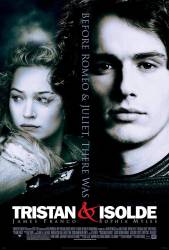Revealing mistake: In the scene where Tristan and Isolde have their first secret talk in the market, when the camera is on Isolde, you can see that she is wearing contacts.

Tristan & Isolde (2006)
Plot summary
Directed by: Kevin Reynolds
Starring: James Franco, Rufus Sewell, Sophia Myles, David O'Hara
Tristan is the orphaned son of a Middle Ages Briton warrior; Isolde is a motherless princess of enemy Ireland. Tristan is raised by his late father's dear friend and is mistakenly "buried at sea" following a battle. Isolde and her maid find him washed up on the Irish beach, and secretly nurse him back to health. Isolde does not tell Tristan her real name-she tells him her name is Bronya and that she is a lady in waiting at the Irish court. They fall deeply in love and are separated once Tristan recovers. In an attempt to reconcile the warrior factions of Ireland and Britain, the King of Ireland, Isolde's father, offers his daughter to the champion of a 'who's the best' contest. Tristan "wins" Isolde on behalf of Marke, the man who raised him-but doesn't know that Isolde was his true love until she lifts her veil at the contest. Tristan and Isolde conduct a clandestine affair behind Marke's back. Their deception is uncovered by one of Marke's underlings, who's really in cahoots with the King of Ireland. Though he could have had them both killed, Marke, who loves them both dearly, sets both Isolde and Tristan free, on the eve of an attack by the Irish. Tristan sends Isolde and her maid away and runs back to join the fight. Of course, Isolde gets back to shore to find him. Tristan is mortally wounded in battle, the Irish are subdued and Tristan dies in Isolde's arms. The movie concludes with a note that Marke became the new 'king' and Isolde disappeared after burying Tristan, her true love.
Kimby





Answer: Both or either. Basically what she's asking is, "Are you really mine and no one else's?"